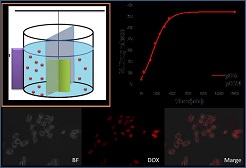Ankan Dutta Chowdhury
National Chiao Tung University, Taiwan
Title: Doxorubicin conjugated Fe3 O4 -GQD nanoparticle for magnetically targeted and ph responsive drug delivery vehicle: a two way targeted approach
Biography
Biography: Ankan Dutta Chowdhury
Abstract
Fluorescence imaging using doxorubicin (DOX) has been used to image free and encapsulated drug uptake into cells, since intercalation of Dox with DNA leads to a characteristic change. However, suitable nano-conjugates which can able to deliver Dox in a much targeted manner with high specificity in cancer cell are still in extensive search. In this study, we report an anticancer drug delivery system based on doxorubicin-conjugated Fe3O4-GQD based nanoparticles which can act as pH mediated as well as magnetic targeted drug delivery nanocarrier. The as-synthesized nanoparticles consist of uniform spherical size with an average diameter of 35 nm. The drug delivery system demonstrates the ability to release DOX by desorption of drug molecule from GQD surface in mildly acidic environments, mimicking the cancerous cell environment. By functionalizing the surface of the GQD with the iron oxide nanoparticle, the drug releasing phenomenon can be controlled and targeted by the external magnetic effect. The quenching of GQD by DOX due to resonance energy transfer mechanism is applied as optical probe to confirm the DOX conjunction and monitor the release of DOX. The DOX-conjugated nanocarrier exhibits an obvious cytotoxic effect on HELA cancer cells via MTT assay. In addition, the less cytotoxicity of the drug nanocarrier in normal endothelium cell also strongly support the specificity towards the cancer cell which is the most successful aspect of this delivery system. Meanwhile, the successful delivery on magnetic environment of DOX-conjugated nanoparticles was demonstrated through in house made dialysis bag chamber and fluorescence microscopy. Such drug delivery system, which combines pH-triggered and external magnet controlled drug release, has excellent potential applications in cancer therapy and smart imaging. We demonstrate here that, this new class of nanocarrier can fulfill the required specificity and sensitivity as next generation cancer imaging, therapy and sensing system in vitro.

Recent Publications
1. Highly Sensitive and Selective Detection of Nanomolar Ferric Ions Using Dopamine Functionalized Graphene Quantum Dots, AD Chowdhury, RA Doong, ACS Appl. Mater. Interfaces, 8, 21002–21010, 2016.
2. Rapid Hydrogen liberation from hydrolysis of Sodium borohydride using Ru-Co incorporated PEDOT/PSS nanocomposites as catalyst, AD Chowdhury, N Agnihotri, A De. Chemical Engineering Journal 264, 531-537, 2015.
3. Non-Enzymatic Electrochemical Detection of Cholesterol using β-Cyclodextrin Functionalized Graphene, N Agnihotri#, AD Chowdhury#, A De (#equal contribution) Biosensors and Bioelectronics 2015.
4. Detection of positional mismatch in oligonucleotide by electrochemical method, AD Chowdhury, N Agnihotri, A De, M Sarkar Sensors and Actuators B: Chemical 202, 917-923, 2014.
5. Highly sensitive electrochemical biosensor for glucose, DNA and protein using gold-polyaniline nanocomposites as a common matrix, AD Chowdhury, R Gangopadhyay, A De Sensors and Actuators B: Chemical 190, 348-356, 2014.

